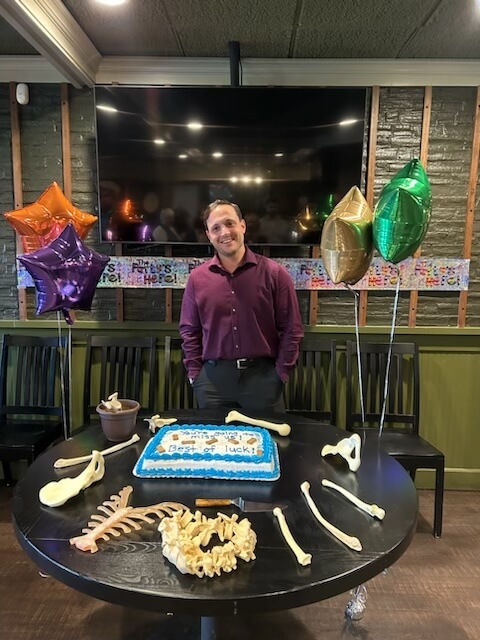
Dr. Ryan Harrod was the March presenter in the Joan Crawford Lecture Series at the Performing Arts Center at Garrett College.
Dr. Ryan Harrod readily admits anthropologists haven’t always had the best reputation.
“There’s been a lot of distrust in anthropologists in general,” Harrod said during his Joan Crawford Lecture Series presentation last Wednesday night at the Performing Arts Center at Garrett College.
“We’ve done some bad things – stole some bodies, put stuff in museums that we didn’t have permission to exhibit,” said Harrod, quickly adding he “hasn’t done any of that.”
Although, Harrod noted, he wouldn’t like to have to prove that to a suspicious law enforcement professional.
“If you’re ever pulled over, there can be real questions if you have a skull or a skeleton in your back seat,” said the University of Alaska Anchorage associate professor, who has on occasion driven remains from dig sites to laboratories.
All joking aside, Harrod said one of his professional goals is to practice “community-driven bioarchaeology”. That includes, according to Harrod, working with and supporting Indigenous communities that want to learn more about their past, including respectful analysis of ancestral human skeletal remains discovered in those communities.
“I’ve been pushing for about 15 years for more indigenous-led research and indigenous-centric research that doesn’t discount local oral history,” said Harrod. “People will tell us things and then we will find through bioarchaeologic research that it’s exactly as they described it. Archaeologists used to routinely discount oral histories.”
Harrod – who served as Garrett College’s dean of academic affairs from 2021 to 2023 – said Alaska is a veritable gold mine for bioarchaeologists due to its environment.
“Permafrost preserves all kinds of things,” observed Harrod, referring to the thick subsurface layer of soil that remains frozen throughout the year in polar regions.
Those environmental factors permit bioarchaeologists to use Alaska’s past to shed light on present-day problems. Harrod cited the Brevig Mission’s impact on research into the Spanish Flu pandemic of 1918 as a perfect example.
“Seventy-two of 80 residents of this mission died of the Spanish Flu,” said Harrod, noting researchers determined the harsh Alaskan environment provided “well-preserved remains that might contain the influenza virus.”
“What happened in that community was a horrible tragedy, but it also produced a community where researchers could come back and learn about the virus,” explained Harrod.
In fact, one researcher who began working at the Brevig Mission site in 1951 – virologist William Hall – successfully obtained DNA containing the virus from Brevig Mission grave excavations in 1997. And that research had 21st-century implications for everything from the H1N1 virus of the 2010s to the COVID-19 pandemic.
“The 1918 flu was the same as the H1N1,” said Harrod, adding he reminded one of his UAA classes of that when they were minimizing the dangers of H1N1 during the U.S. outbreak.
“I was like, ‘Hey, in a town of 80 people, more than 90 percent of the population died from the 1918 flu – this [H1N1] can be an extreme event,’ ” recalled Harrod.
Harrod said Alaska is also an information-rich territory for bioarcheologists due to the number of ancient archaeological sites. Swan Point is Alaska’s oldest verified archaeological site at about 14,000 years, but there are other sites in Alaska that might be even older, according to Harrod.
Harrod discussed work performed with collaborators, including Emily Corley, Norma Johnson, Margan Grover, Ted Parsons, Kaelyn Nutukŋinoun Schenkenberger, Dr. Gerad Smith, and Tyler Teese. He also talked about the subfields of biological anthropology that comprise bioarchaeology: skeletal biology and osteology, paleopathology, and forensic anthropology.
“I’m interested in questions having to do with identity, health and disease, conflict and violence, social inequality, ethics, and repatriation,” Harrod said of his own work.


